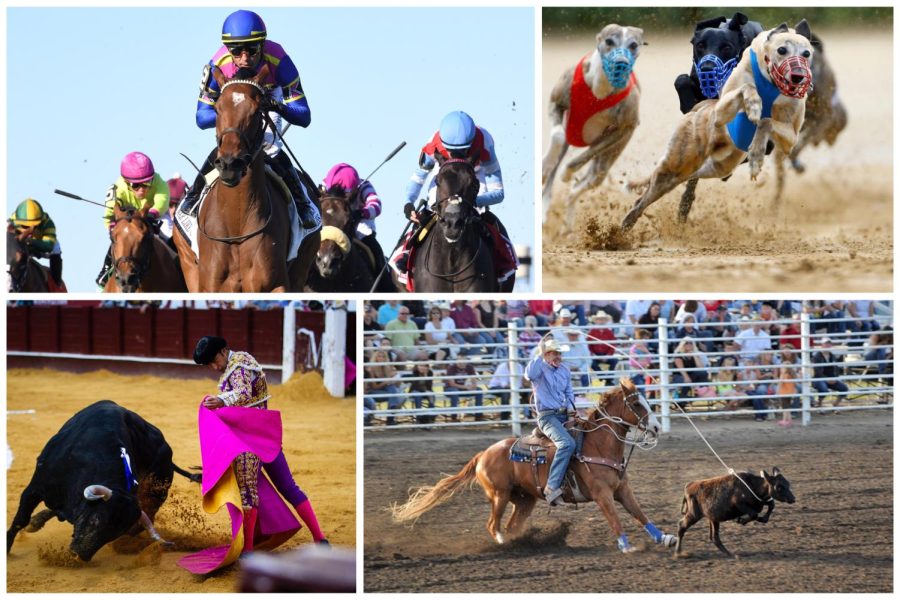The sidelines: the use of animals in sports

More stories from Olivia Oorbeck
Sports have always taken an important seat in people’s lives. You can see evidence of sports all over the world, from European football to Canadian ice hockey, from Chinese ping pong to Kenyan running and American baseball. Almost all humans have had some exposure to sports and many have not only played but also experienced fun and entertainment from sports. In fact, “Evidence shows sports existed long before there was even civilization. Ancient cave drawings seem to show sprinting races and wrestling matches that date back over fifteen thousand years,” says J. Will, an author who wrote the article “History of Sports | Sports Through the Ages”.
Because sports have played a huge role in society, it is not surprising that we as humans have included animals in some sports, but sometimes to the detriment of the animal. Some of these sports that include animals include horse racing, equestrian, dog racing, rodeos, rat races, and even dog fights. There has been a big question that has been lingering over many individuals for a long time now: Is it good for animals to be involved in sports for our pleasure and enjoyment?
It is not easy to make a decision about animals involved in sports. Sometimes, the answer is very obvious. For instance, dog fights are illegal and cause injury and death to the majority of the dogs that are involved. This is easy to determine that it is not a worthwhile sport, no matter who claims otherwise. However, the sport of horse racing is not as obvious to be associated with the negative stigma, yet some would argue it is just as bad.
For instance, horse races, such as the Kentucky Derby, may seem to be a sporting event where horses are cared for, but that is not entirely true. “In 2014, PETA posted an investigation to YouTube, honing in on one of the country’s most successful racehorse trainers, Steve Asmussen. As a regular at the Kentucky Derby, he has an extensive record of rule and drug violations. He is notorious for putting his horses through tremendous pain and exhaustion, treating his horses like ‘disposable commodities,’ and giving his horses a ‘steady diet of drug cocktails,’” said Lizzy Rosenberg, author of the article “The Kentucky Derby Has a Dark History of Horse Abuse”. The article goes on to state that many horses will eventually be euthanized due to poor caregiving and long-term damage the horse experiences from drugs and lack of proper care.
It is sad, but many of these horses are bred for one thing and one thing only: to be the fastest horse on the track. Unfortunately, with this comes many implications, such as fatigue, broken bones, and life-threatening injuries in main areas like the muscles, bones, tendons, and ligaments. To make things worse, animals cannot communicate their pain and suffering like a human athlete can. Often, horses are pumped full of drugs in order to get them back out on the track again if they become injured. Those drugs, although legal in most cases, can make a horse run faster but can also mask pain. The labs cannot detect all of the illegal drugs out there. Due to many horses who are being pumped full of a large variety of drugs, they often become addicted. This leads to their tattered bodies turning into shells of their former selves, even leading sometimes to their death.
Horse racing and dog fighting are not the only sports that can be considered cruel and harmful to the animals involved. Rodeo is another major sport that includes animals and can be considered cruel and torturous. Rodeos have been a large aspect of American society. They can be entertaining social events with fun costumes and incredibly talented athletes like bull riders, barrel riders, and even clowns. Because of this, many turn a blind eye, and some do not even realize what is happening inside and outside the rodeo ring. Many rodeo animals are shipped over long distances without food, water, or a way to relieve themselves. Often, the animals travel within trailers or train cars standing or packed into a small area and are in very uncomfortable environments to travel.
There is also a great deal of suffering during practicing as well. A prime example would be calf roping. Calves are used as a way of entertainment for the people in the stands. Calves are forced to run through a shoot into an open pen. The majority of the calves weigh less than 300 pounds and yet they are being forced to travel in the shoot at a high speed. For calves this size, it is quite unusual for them to be able to run at top speeds like this, but they are forced to run fast in order to try and escape. In the article “Rodeos: Inherent Cruelty to Animals”, written by Peggy W. Larson, she explains that “They are tormented in the holding chute: their tails are twisted, their tails are rubbed back and forth over the steel chute bars, and they are shocked with 5000-volt electric prods until the gate opens.” The torment that they experience, for the satisfaction of humans watching them run, only to be stopped short with a rope to their neck and then tend to choking, is not just cruel but also inhumane and should be stopped.
There are also other cultures that indulged in sports with animals, and they also can have a largely negative impact on animals. One example would be the bullfighting that is popular in countries like Spain and Portugal. Bulls are put into pens and forced to fight to the death. “The bull enters the arena and is approached by picadors—men on horses who drive lances into their back and neck muscles. This attack impairs the bull’s ability to lift his head and defend itself. The picadors twist and gouge the lances to ensure significant blood loss.”
There are so many examples of cruel and inhumane treatment of animals in sports and sporting events. The animals utilized for sports have no say in what happens to them or how they participate. Many animals involved in sports are used for the entertainment and enjoyment for humans. Unfortunately, we ignore the treatment of animals in exchange for a night of entertainment. We are not honest with ourselves about what is truly being done to these animals, yet we enjoy it and are entertained by the event. We think we are watching simple, lighthearted competition while many of the animals are abused, maimed or possibly killed for our benefit. Is this really a necessary form of entertainment?

Olivia Oorbeck is a senior on the FHC Sports Report. She is excited about entering her second and final year on the staff. This year, she received the...




diana mayer • Nov 15, 2024 at 10:23 AM
This is barbaric and mind blowing that it is still happening. How is this legal and what kind of people are organizing these events. there should be legal action taken after these organizers
Charles Povlitz • Nov 8, 2022 at 8:13 PM
Interesting perspective. Most folks have not given this subject much thought. We tend to take things for granted “that it has always been done this way”or “they are just animals”. Maybe we should all reconsider if this the correct way to do things. Thanks for making me more aware.